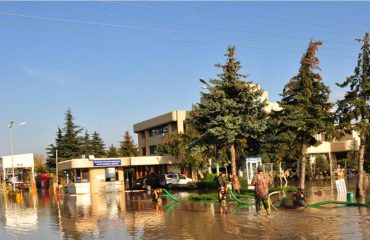
When flood waters begin to recede from your building, a professional cleaning team like BİMTES will be able to initiate the flood damage restoration process. There are a few steps to follow to restore your build:
- Evaluation of water drainage and flood damage.
- Safe removal of all furniture and contents that are irreparably damaged.
- Cleaning and decontamination of the structure to remove possible environmental, chemical and/or biological contaminants left by the storm water.
- Complete drying and dehumidification of the structure to ensure that no residual water remains. If these procedures are not followed, it can cause further damage, including mold growth.
Floods have the potential to cause serious disruption to all facilities, so they should be checked by our expert teams before continuing to use them.
What to Know About Flood Damage?
How Can Flood Damage Be Reduced?
When it comes to reducing flood damage, preparation is much easier than repair. Making sure you take both short-term and long-term steps ahead of time to reduce the risk of flood damage can provide vital protection in the event of a flood. Short-term preparations are things you can do when the possibility of flooding is imminent, while long-term preparations are more permanent changes you can make before any bad weather happens.
In the short term, the use of sandbags to move materials from the ground floor to the upper floor rooms, remove furniture from the floor, and close the floodwater entry points can be effective in minimizing damage. Long-term flood mitigation measures may include improving land classification or slope, changing landscaping, installing water barriers and new drainage systems.
What Causes Flood Damage?
Flood is a common type of natural disaster in Turkey and is most commonly defined as a temporary flooding of normally dry land. Flooding can be caused by rain, snow, coastal storms, storm surges, flooding of dams and other water systems.
How to Deal with Flood Damage
When dealing with serious flood damage to your structure, the best and safest option is always to seek professional help. Amongst the waste pollution, possible interference with electricity and other hidden dangers, flood water can be dangerous and cause many types of damage, both visible and invisible. Proper drying, decontamination and dehumidification are necessary to ensure that no further damage is done to your structure.

 Türkçe
Türkçe 



![muddy-water-removal[1] su tahliyesi ve kurutma](https://bimtes.com.tr/wp-content/uploads/2022/03/muddy-water-removal1-370x240_c.jpg)
![water-banner[1] su hasarı](https://bimtes.com.tr/wp-content/uploads/2022/03/water-banner1-370x240_c.jpg)